Tracy Arm Fords Terror Wilderness
Blue Ice on a Rainy Day
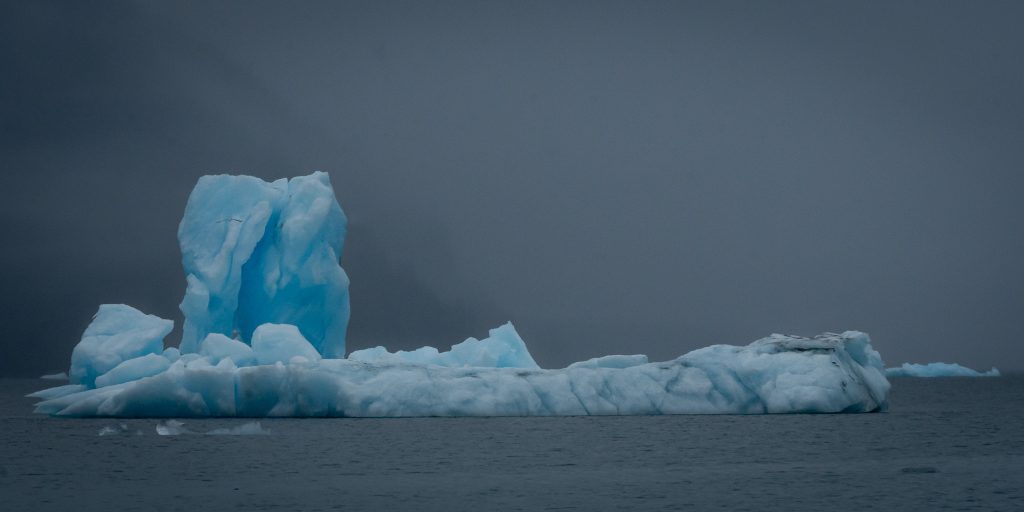 Rainy days are one of my guilty pleasures. Partly because the David B is always so warm and cozy on the inside, but also because rainy days accentuates the blueness of icebergs. This was my favorite iceberg from last year. I was really impressed with the way the two towers stayed propped up against each other as they floated around in Endicott Arm. To learn more about our Alaska cruises.
Rainy days are one of my guilty pleasures. Partly because the David B is always so warm and cozy on the inside, but also because rainy days accentuates the blueness of icebergs. This was my favorite iceberg from last year. I was really impressed with the way the two towers stayed propped up against each other as they floated around in Endicott Arm. To learn more about our Alaska cruises.
Mother Natures’s Art
I’ve been looking at these scales, or chatter marks as they are called, near Dawes Glacier for years. I love showing them to our guests. They always feel impactful to me. Maybe it’s because they weren’t yet exposed when John Muir visited Dawes in 1880, or perhaps it’s just Mother Nature’s raw talent as an artist. Whatever it is, this part of Endicott Arm is one that I always enjoy gazing at.
-Christine
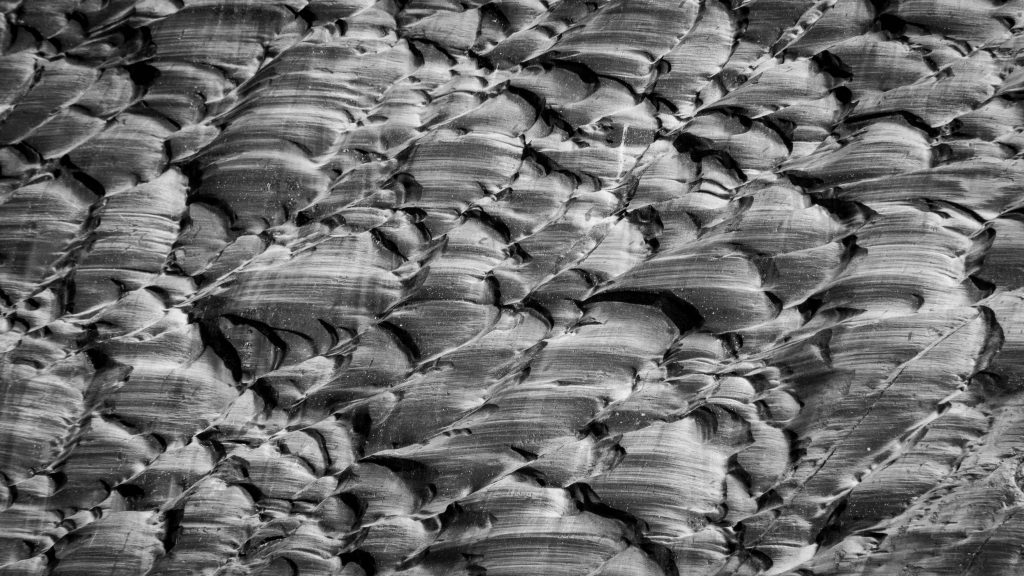
Wait for it…
One of the most thrilling things we get to do on our cruises is to wait and watch for glaciers to calve. Just when you think it’s time to go and you’ll be disappointed that you didn’t see anything big, the glacier answers with a thunderous crack and an enormous splash.
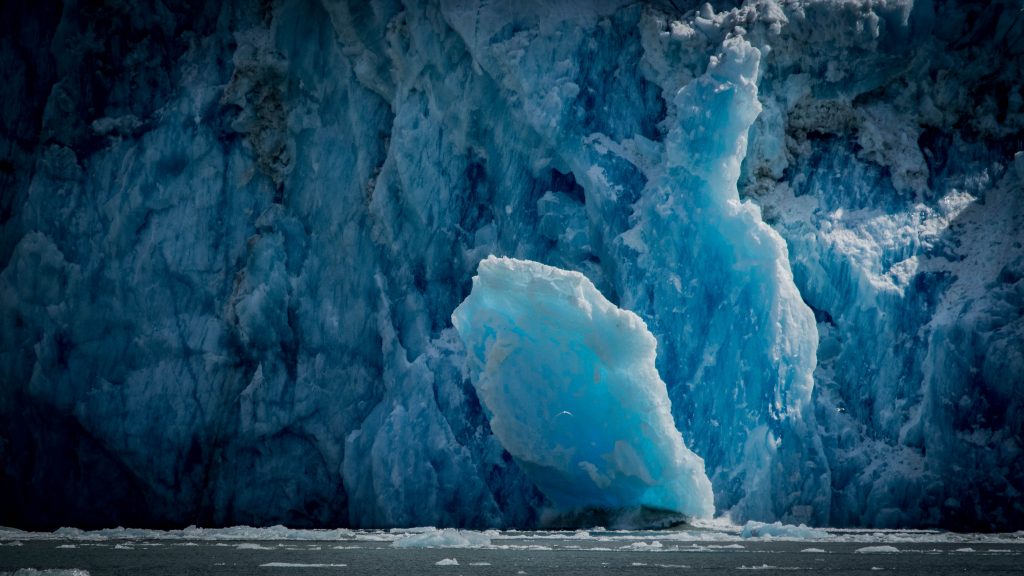
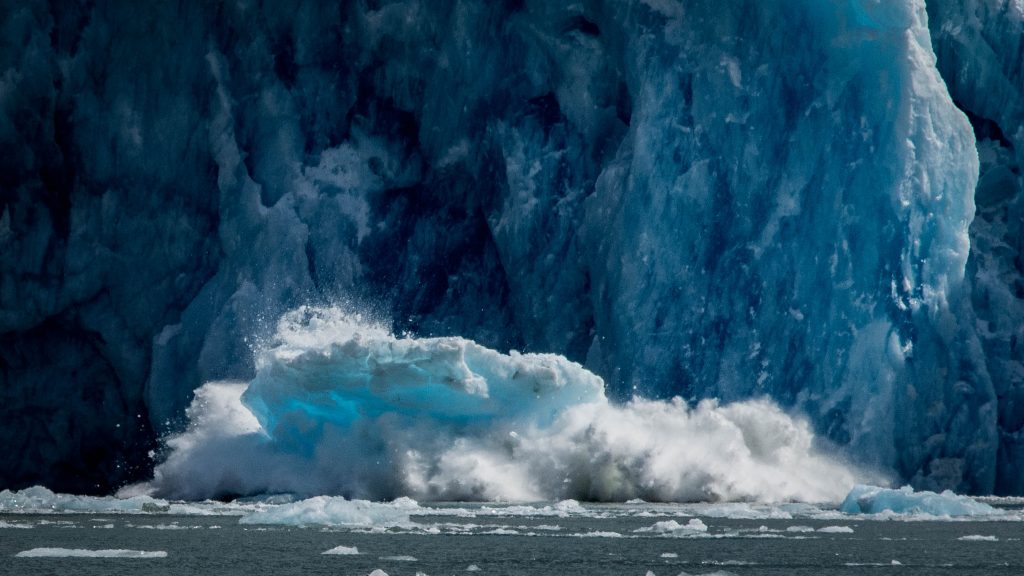
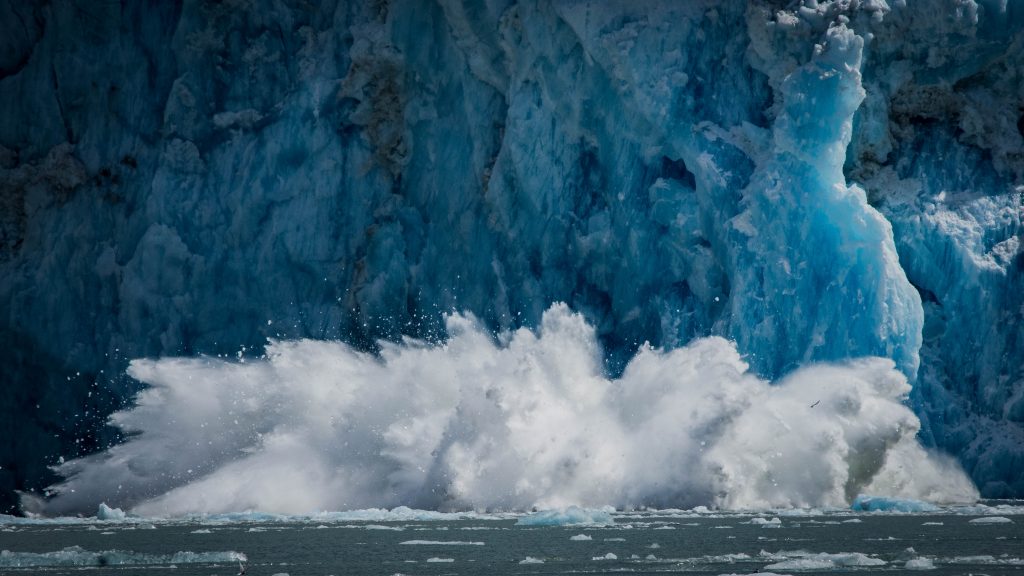
The ice mountain is well disposed toward you
 There’s often a cold breeze blowing off the glacier when we arrive to admire it’s icy blue front. Wind that can make July feel like January. It plays games with my seasonal clock. I remember one time while watching Dawes glacier, a guest told me he was going to go river rafting in a week when he got home. I gave him a quizzical look. It took me a moment to remember that it was July, and the rest of the North America was enjoying water slides and shaved ice, not icebergs sliding into sea water.
There’s often a cold breeze blowing off the glacier when we arrive to admire it’s icy blue front. Wind that can make July feel like January. It plays games with my seasonal clock. I remember one time while watching Dawes glacier, a guest told me he was going to go river rafting in a week when he got home. I gave him a quizzical look. It took me a moment to remember that it was July, and the rest of the North America was enjoying water slides and shaved ice, not icebergs sliding into sea water.
Visiting a tidewater glacier in Alaska is pilgrimage. You go observe something bigger than yourself in nature. It’s something you need do. For us, getting to the glacier is part of the journey. It’s more than just checking it off as a bucket-list item. On the David B, we are tuned into the rhythm of the glacier and the ebb and flow of the tide as it carries discarded icebergs up and down the fjord. We watch the glacier’s ever-changing snout and it’s mood. We’re aware that the glacier sometimes makes us work hard for our visit by packing the fjord densely with ice shed from its towering face. Sometimes its bergs are enormous – big like a building. Sometimes they are small – like a basketball. Some are white, some are blue, some have dirt and rocks riding along. Some have seals nursing their young. Some are clear and difficult to see. (We call those sneakers.)
Iceberg sizes have official names too. Most of the ice we see in Endicott Arm or Tracy Arm are growlers, less than 1 meter above the water and and less than 5 meters long. We also see lots bergie bits that are up to 4 meters above the water and and 14 meters long. The small and medium
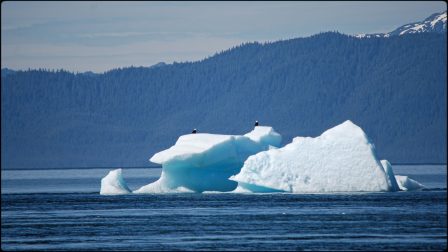 icebergs, which range in size from 15 meters high to 45 meters high are often floating at the entrance to the fjords. The large and very large icebergs, which top out at over 75 meters high are rare.
icebergs, which range in size from 15 meters high to 45 meters high are often floating at the entrance to the fjords. The large and very large icebergs, which top out at over 75 meters high are rare.
Picking our way though the ice is always a challenge, and depending on the mood of the glacier, it can make for a long day. When we travel to a tidewater glacier, we always have two hopes. The first one is that the ice in the fjord will be light and the work of getting there will be easy. The second hope is that when we arrive, the glacier will awaken, and as Captain Tyeen said to John Muir in 1880, when they first saw Dawes Glacier, “The ice mountain is well disposed toward you. He is firing his big guns to welcome you.”
This past year we had several good visits to Dawes glacier, the ice was light and the glacier did fire its “big guns,” but one day stood out. It was a cool day with a strong wind coming off the glacier. Travel was relatively easy. Jeffrey piloted the David B to about 400 meters from Dawes’s formidable blue-white front. The feeling is always the same for me. I feel really small when I’m face to face with Dawes, which towers like a wide-angle skyscraper. At 400 meters, the wind, as if laughing at our smallness, pushed us back away from icy Dawes. We were the only boat there. Jeffrey re-positioned the David B several times, and each time we faced the glacier again. Our reward came with patience, hot coffee, mittens, and hats. The glacier became well disposed toward us and began to “fire it’s big guns”.
 It started with a cracking and a rushing sound. Ice sloughed off the center-right side dumping a cascade of bergie bits and growlers. It continued and dumped some more, then something big broke, and more bergie bits and maybe even a small or medium iceberg was cast away from Dawes. The sounds and the sight made my heart beat quickly with excitement. Soon the waves arrived with a long low gentle role. We moved in sync with the nearby growlers and bergie bits.
It started with a cracking and a rushing sound. Ice sloughed off the center-right side dumping a cascade of bergie bits and growlers. It continued and dumped some more, then something big broke, and more bergie bits and maybe even a small or medium iceberg was cast away from Dawes. The sounds and the sight made my heart beat quickly with excitement. Soon the waves arrived with a long low gentle role. We moved in sync with the nearby growlers and bergie bits.
When the show began to slow up, Jeffrey moved us into the wind one more time. It was time to go. The ice mountain was good to us, other boats were approaching, and a hot bowl of chili and sweet cast-iron-baked cornbread with melting butter was waiting in the galley.
-Christine
Going Ashore in the Wilds of Alaska
 From the bow of the skiff, I watch for bears and submerged rocks as we close in on the beach. In the final moments before I hop out, Jeffrey cuts the motor and lifts its prop out of the water. The sandy beach greets the fiberglass with a scratchy hello. Jeffrey instructs our guests to sit back while I step ashore and pull the boat up a little higher. Our guests climb out of “Skiffy” and after a radio check, a quick chat about the pick-up time, and meal prep, I push Jeffrey and Skiffy back out into the water. He’ll be back in a few hours.
From the bow of the skiff, I watch for bears and submerged rocks as we close in on the beach. In the final moments before I hop out, Jeffrey cuts the motor and lifts its prop out of the water. The sandy beach greets the fiberglass with a scratchy hello. Jeffrey instructs our guests to sit back while I step ashore and pull the boat up a little higher. Our guests climb out of “Skiffy” and after a radio check, a quick chat about the pick-up time, and meal prep, I push Jeffrey and Skiffy back out into the water. He’ll be back in a few hours.
It’s quiet. We’re on the beach. No cars, no cell phones, no Wifi, no pressures. Just me, six people, and the wilderness.
We go ashore because the wilderness is a real place. It’s more than a backdrop of beauty to pass by balcony windows and outside decks of larger cruise ships. Yes, the David B, is a warm, cozy vessel for cruising in Alaska, but Jeffrey and I have a greater goal for the David B’s
cruises– to experience the wilderness, where it’s fresh, it’s clean, it’s wild. It’s a p lace too few people know anymore, and at a time when nature and wilderness are what we need to find calm in our ragged, over-scheduled lives. No matter how addicted I am to my distracted wireless life during the off-season, (and trust me, I can’t leave my device alone when a connection is available,) I yearn deeply for my summer
lace too few people know anymore, and at a time when nature and wilderness are what we need to find calm in our ragged, over-scheduled lives. No matter how addicted I am to my distracted wireless life during the off-season, (and trust me, I can’t leave my device alone when a connection is available,) I yearn deeply for my summer
months on the David B, with our guests, in the wilderness of southeast Alaska. It’s a place where we can squat down next to a tide pool and lose track of time watching the rhythmic motion of the tiny feathery appendages that barnacles sweep the water with, while hermit crabs fight, sea-stars hunt, and small fish dart with lightning speed for a safe haven between sponge encrusted rocks.
 If there were more people than just our small group it wouldn’t be the same, and our group size allows us to have permits to take people to really special places. Places that other boats with more than twelve passengers cannot take their guests. Places few people ever touch foot. Going ashore is where you feel the power of Alaska, its nature and the draw of wilderness. When I push back on the branches of a Sitka spruce and the thorny leaves of a Devil’s club, to open up a passage into an ancient forest where the trails are made only by bears and deer, I know we are truly stepping into the real Alaska. We are getting more than just pretty backdrop scenery on the way to the next town and t-shirt shop, and we’re experiencing a transformation in ourselves as the timelessness of the wilderness whispers of our ancient and lost connection to nature.
If there were more people than just our small group it wouldn’t be the same, and our group size allows us to have permits to take people to really special places. Places that other boats with more than twelve passengers cannot take their guests. Places few people ever touch foot. Going ashore is where you feel the power of Alaska, its nature and the draw of wilderness. When I push back on the branches of a Sitka spruce and the thorny leaves of a Devil’s club, to open up a passage into an ancient forest where the trails are made only by bears and deer, I know we are truly stepping into the real Alaska. We are getting more than just pretty backdrop scenery on the way to the next town and t-shirt shop, and we’re experiencing a transformation in ourselves as the timelessness of the wilderness whispers of our ancient and lost connection to nature.
I hope to get to walk ashore with you this summer.
-Christine